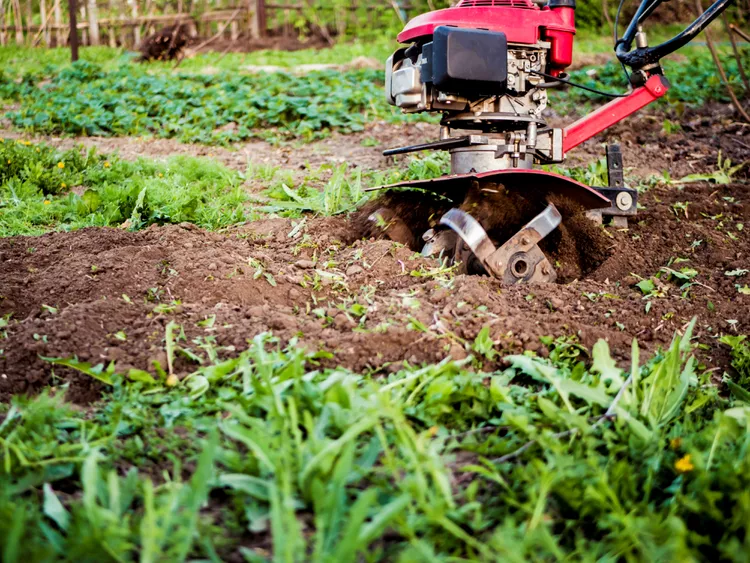Tillers and cultivators appear similar, and both dig up the soil, so are they really different? Can you use a cultivator to make a new garden bed? Will a tiller be suitable for weeding aisles and pathways? Let’s break down what makes these machines different and which tasks they’re best suited for.
What Is a Tiller?
Tillers are large machines designed for heavy work. They are gas-powered and solidly built. While large tillers can be mounted on a tractor and driven off the tractor’s engine by a PTO shaft, homeowner-sized tillers come in two basic arrangements: front tine and rear tine.
Front Tine Tillers
Front tine tillers are small and light but still meant for work. They are easily maneuverable in tight spaces and, at about 100 pounds, can be picked up by a strong person. The tines are located either in front of or immediately underneath the engine, and the wheels—most often plastic—are to help move the tiller around, such as from the garage to the garden.
Rear Tine Tillers
Rear tine tillers are larger workhorses meant for bigger areas and tougher tasks. With larger engines and heavy-duty transmissions, these tillers weigh 300 pounds or more. The tines are located behind the engine, and the tires look like small tractor tires and are powered to help you move the machine.
Some rear tine tillers have multiple speeds, including reverse, and can rotate the tines forward or rearward, called counterrotating, for different tasks. Rear tine tillers can be expensive.
What Is a Cultivator?
Cultivators are smaller machines meant for lighter work and smaller spaces. They can be gas, electric, or battery–powered and can be picked up and carried to a job.
Cultivators have rotating tines like tillers, but the tines are made out of thinner, less heavy-duty steel and often rotate much faster. A cultivator’s smaller size and lower power make it easier to control, especially around plants or garden bed edges.
Electric cultivators are quieter, lighter, and require less maintenance than gas-powered models. Newer versions often have power similar to small gas models. They can be corded or cordless.
If you can pick it up and carry it with one hand, or it’s electric, you’re looking at a cultivator. If you’re thinking about calling over the neighbor’s 6-foot-tall teenager to help lift it, it’s a tiller.
Picking the Right Machine for the Job
Choosing the right machine can be made more difficult by the retailer or manufacturer using the wrong name for the equipment. Many cultivators are purposely labeled as tillers when their construction reveals they are not.
Likewise, many tiller manufacturers show pictures of individuals using a large tiller to weed tight aisles between rows of a fully grown vegetable garden, using only one hand to control the large machine to show how “easy” it is. Don’t fall for it. Choose the right tool for the job, and you’ll be much happier. Using one machine for both roles is an exercise in frustration.
Either machine can be forced to do tasks meant for the other, but it isn’t ideal. A cultivator can break the ground for a new, small garden bed, although it may take some time and frustration. A tiller can be made to work between the rows for cultivation or mixing soil amendments in large established beds. Some older front-tine tillers allow all but the two center tines to be removed for precisely this purpose, but they aren’t easy to use that way.
Think of it like lawnmowers. There are riding mowers for big areas (rear tine tillers), push mowers for medium and small-sized lawns (front tine tillers), and string trimmers for light work and close cutting (cultivators). While you can cut an acre of lawn with a string trimmer, you won’t enjoy it. Trying to get close to trees, flower beds, and the garage wall with a riding mower won’t leave as nice a job as you want. Choose the right tool for the job and make life easier.
Breaking Ground for a New Garden
Creating a garden bed out of an existing lawn is a prime job for a tiller. Its stronger construction, larger and heavier tines, and more powerful engine are designed for this exact task. A rear tine machine with counterrotating tines is the best choice, especially for hard ground, but all tillers can do the job.
Spring Planting Prep in Established Beds
Garden beds with already loosened soil, like your several-year-old vegetable patch, can be refurbished in spring by adding amendments, such as compost. Many people use garden forks or broad forks to minimize soil disturbance. However, if you opt for a power tool to help out, the cultivator is ideal for this role. These tools do best at mixing in amendments and loosening the top 2-3 inches of soil, and you won’t wear yourself out muscling a heavy machine around.
Weeding Aisles
Garden aisles can get away from us, and sometimes, a little help from a power tool is in order. Cultivators are ideally suited for this task, and their lower power and light weight help keep them under control so they don’t stray too close to rows of plants and damage roots or run right over them. A tiller works for wide aisles, but stick to a cultivator near plants.




















